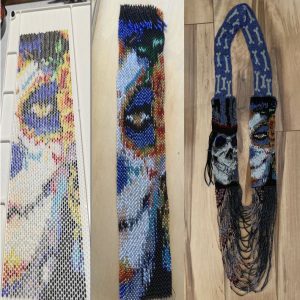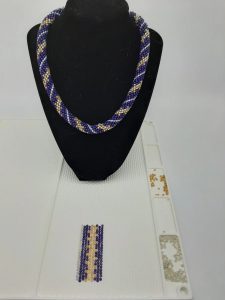
What is a seed bead?
As an avid beader, I just love working with tiny seed beads! Seed beads are essentially very small glass beads that measure between 1 to 2.5 millimeters in diameter. They come in a huge variety of colors, finishes, and even shapes. The name “seed bead” refers to how teensy these beads are – about the size of a seed!
Seed beads originate from Venice, where they were first created by glass artisans during the 15th century. Back then, they were an expensive trade item that opened up new creative horizons. Today, seed beads are inexpensive and widely available, which is part of what makes them so fun to work with!
I like to think of seed beads as the ultimate embellishment. They can be used to add delicate detail, texture, and color to just about anything. Jewelry makers often stitch seed beads onto fabric backings to create stunning earrings, necklaces, bracelets and more. Clothing and accessory designers will sometimes sew them onto garments and bags as an exquisite decorative touch. Seed beads can also be used in traditional Native American beadwork, like the intricate patterns and designs seen on moccasins and regalia. Basically, if you can dream it up, there’s a good chance seed beads can help make it happen!
The tiny size of seed beads allows for a level of detail and precision that’s hard to achieve otherwise. I find working with these diminutive beads so relaxing, as I get into a focused, meditative state. Plus it’s just plain fun to see your materials and skills turn these itsy-bitsy beads into something beautiful! There’s an endless array of colors and finishes like metallic, clear, frosted, and more. It’s no wonder seed beads have been a staple embellishment across cultures for centuries. And they never seem to go out of style!

Construction techniques
Ooh, now you’ve got me geeking out over the whole process of how these teeny-tiny works of art come to be! The creation of seed beads is such an intricate craft that’s been passed down for generations.
It all starts with forming the glass itself. Seed beads are crafted from drawn glass, meaning artisans use a torch to melt glass canes or rods. The glassmaker will heat the end of the rod until it becomes malleable enough to stretch and pull into a long tube. The long, thin tubing is allowed to cool and then chopped into miniature beads. Skilled hands can draw glass so fine that the resulting beads are barely bigger than a pinhead!
The drawn glass method allows for multicolored seed beads too. To achieve this, colored glass rods are bundled together and drawn out in parallel, fusing together as they’re stretched so a single bead contains multiple swirls of color. The options for color combinations are limitless!
Once the little glass beads are formed, they still need to be smoothed and polished to achieve a glossy finish. The beads are tumbled and shaken in drums along with soft abrasives to wear down any rough edges. This also enhances their shine. Some beads are then coated in a silver or gold luster for extra sparkle!
The last steps are all about precision sizing and sorting. Seeds beads need to be meticulously grouped by size, shape and color. This ensures consistency when used in delicate beadwork. Each impeccable, tiny bead passes through many skilled hands before making its way to us crafty beadheads!
Whenever I work with seed beads, I’m reminded of the generations of artisans who’ve mastered the technique of crafting and perfecting them. Their knowledge lives on in every delicate bead. Makes me want to really honor that history in the beadwork I create!

Varieties
Get ready for some serious eye candy, because the varieties of seed beads out there are soooo gorgeous! From colors to shapes to finishes, there’s no shortage of options to make your beadwork pop.
Let’s start with colors. There are literally thousands of different seed bead shades, from solids to multi-colors to color lined (where the bead’s outer layer appears one color until you look inside). You can find any color of the rainbow and more – earthy neutrals, vivid brights, pale pastels, deep jewel tones. I’m mesmerized browsing the color card at the craft store!
Shapes also provide visual interest. While round is the most common, you can also find seed beads in fun shapes like triangles, cubes, rectangles and hexagons. Mixing in different shaped beads brings cool new dimensions to beadwork.

The Day of the Dead necklace was designed by Sandey Elzea.
And don’t get me started on finishes, which give beads amazing depth! Opaque, transparent, matte, metallic – the options are endless. Some of my faves are the super sparkly rainbow luster and the duo-chrome beads that look one color from one angle and another color when you turn them.
From India to the Czech Republic to Japan, seed beads are crafted around the world, bringing their own specialties. Vintage beads can provide a historic touch, or grab the latest color trends for something fashion-forward. No matter what your style, there are so many types of seed beads to make it your own.
When I sit down to design a new beaded piece, it’s like a candy store of possibilities! Do I want an intricate pattern of multiple colors or a simple look with beautifully textured metallic beads? The creative options with seed bead varieties are infinite. It’s no wonder I can spend hours happily sorting and admiring these tiny treasures!
Shapes
When it comes to seed bead shapes, there’s a whole world of options to explore!
- The most common shape is the round seed bead, which comes in endless size variations. The classic round shape works well for all kinds of designs and techniques.
- Bugle beads are long, tubular seed beads that are often used to add elements of drape, flow, and movement to beaded designs. The elongated bugle shape works well for fringe, tassels, and other hanging details that showcase the gravity-defying nature of these diminutive glass tubes.
- Squares, triangles, rectangles, and other polygonal beads provide graphic pop. They are great for mosaic style patterns.
- Molded and pressed beads resemble flowers, leaves, hearts, and other charms. These add delicate detail and realism.
- Faceted cuts on beads make them sparkle. Different facet shapes like hexagons or cubes reflect light uniquely.
- Diamond cut seed beads have an elegant brilliance. The octagonal cut beads have eight distinctive sides.
- Disk shaped beads work well as spacers and links. Their flat shape complements the rounder seed beads.
- Coin and piston shaped beads have a substantial presence. They make bold focal points in designs.
- Two-holed beads act as connectors and allow more intricate patterns. The extra hole adds design flexibility.
- Teardrop, kite, and cornflake shaped beads create fluid lines and movement. Their asymmetrical forms are visually dynamic.
The possibilities are endless with the array of seed bead shapes out there! Exploring new bead shapes keeps my designs fresh and exciting.
Shapes Of Seed Beads
 As a beadaholic, I’m absolutely obsessed with all the amazing shapes and forms seed beads come in! Beyond the classic round shape, there’s a kaleidoscope of options to make your designs pop.
As a beadaholic, I’m absolutely obsessed with all the amazing shapes and forms seed beads come in! Beyond the classic round shape, there’s a kaleidoscope of options to make your designs pop.
Some of my favorite unique shapes are triangles, rectangles, squares, and hexagons. Switching up the geometry adds cool new dimensions and textures. Triangles can mimic scales or sequins, squares and rectangles have a retro pixelated feel, and hexagons fit together in really cool tessellated patterns.
Seed beads also come in fun oval, teardrop, and disk shapes. Ovals create flowy lines, teardrops add sweet details, and disks work great as spacers and connectors. They make ordinary materials like string and wire look exceptional!
Don’t forget about molded and faceted beads with delicate cut patterns. You can find seed beads shaped like flowers, leaves, hearts, stars, and all kinds of charms. Faceted beads catch and reflect the light in mesmerizing ways.
Japan in particular is known for their innovative pressed glass beads in unique cylindrical, tab, and diamond shapes. They totally transform traditional seed bead designs into 3D works of wearable art.
Combining different shaped seed beads together in one piece can have an almost mosaic or pixelated look. Your imagination is the limit when playing with all these shapes! I love exploring how various forms and silhouettes work together.
It’s incredible how altering the basic shape offers so many options for one tiny bead. As much as I adore the classic round seed bead, I can’t resist sampling exciting new shapes and forms to see where they take my creativity. It makes beading feel brand new again!
Sizes & Units of Measure
As a devoted beadhead, I’m slightly obsessed with understanding all the different seed bead sizes out there and how they are measured. It’s key info for picking the perfect beads for your designs! Let me break down the nuances.
Seed beads range from impossibly tiny, measured in tenths of millimeters, up to about 5mm. The general size classes are:
- 10/0 seed beads = 1 mm
- 11/0 seed beads = 0.9 mm
- 12/0 seed beads = 0.8 mm
- 13/0 seed beads = 0.7 mm
- 14/0 seed beads = 0.6 mm
- 15/0 seed beads = 0.5 mm
The more zeros in the size number, the smaller the bead hole and diameter. As you go up in number, the seed beads get progressively daintier.
You may also see beads measured in inches. Common conversions are:
- Size 11 = 2.5 mm
- Size 13 = 2 mm
- Size 16 = 1 mm
- Size 18 = 0.7 mm
It takes experience and close observation to discern subtle size variations. I like to line up beads in order before starting a project to compare. And quality calipers are a beader’s best friend for precise measuring.
Understanding seed bead sizes allows me to select my materials intentionally. Tiny 15/0 beads are ideal for delicate details, while larger 11/0’s make bolder statements. I love exploring the full spectrum of sizes for contrast and drama! It makes all the difference in achieving your desired effect.
So next time you sit down to bead, take a moment to note those size codes and measurements. It will give you a whole new appreciation for just how minute seed beads are – tiny works of art!
National Origin
As a bead history buff, I absolutely love learning about the origins of seed beads around the globe! It’s amazing how many cultures have crafted and incorporated these miniature wonders into their traditional arts. Let’s take a quick whirlwind tour!
The earliest seed beads hail from Venice in the 15th century. Venetian artisans perfected the technique of drawing glass to create uniform beads as small as pinheads. Venice dominated the bead trade for centuries.
Bohemia, now part of the Czech Republic, eventually became known for their glass beadmaking mastery. Czechoslovakia produced billions of seed beads for world markets during the 1800s. They specialized in molded, faceted, and colorlined beads.
In France, artisans in Place St-Pierre invented the process of coating beads in silver and gold luster. This innovation added gorgeous metallic finishes to basic glass beads. France also pioneered heishi beads, the tiny rounded seed beads commonly used in Native American jewelry.
 Speaking of Native American culture, their intricate beadwork incorporated seed beads from Venice, Czechoslovakia, France and beyond. Each tribe personalized European trade beads by developing their own symbolic patterns and styles. Simply awe-inspiring!
Speaking of Native American culture, their intricate beadwork incorporated seed beads from Venice, Czechoslovakia, France and beyond. Each tribe personalized European trade beads by developing their own symbolic patterns and styles. Simply awe-inspiring!
Over in India, beadmaking dates back 5000 years! Tiny glass seed beads embellished extravagant fabrics and costumes. India perfected miniature mosaic beads, fusing together colored glass chips into impossibly small designs.
And Japan has produced delicately crafted glass seed beads for over 300 years. Their proprietary technique for pressed glass beads results in the distinctive cylinder and diamond shapes we love.
From tribal art to high fashion, seed beads have ornamented cultures across the globe. It’s amazing how these miniscule marvels connect humanity’s shared love of creativity and beauty!
The World Loves Beading
Seed beads transcend language and geography. Though techniques vary, the impulse to create beauty from tiny glass beads seems innate to humans. Handwork that incorporates seed beads can be found on every continent.
The portability and affordability of seed beads made them ideal for trade. Glass beads spread across the globe through commerce and exploration. Diverse cultures enthusiastically adopted the beads into traditional dress, jewelry, and artworks.
Something about the glinting colors and textures of seed beads draws our eye. The intricate patterns and designs possible with miniscule components astound and delight. Seed beads lend themselves beautifully to storytelling.
Working with diminutive parts requires focus, patience, and creativity. Seed beading engages both mind and spirit. The absorption of working seeded bead patterns has meditative benefits. Beading Designs Boards can help: https://www.ogeesseedbeadingdesignboard.com/ along with very small needles and a steady hand. For those that work similar patterns but with larger beads
Adorning oneself and living spaces with ornate beaded embellishment satisfies a deep need for self-expression, beauty and comfort. Seed beads help fulfill the universal desire to create meaning.
In our fast-paced modern world, beading with seed beads provides community. It connects us to ancient cultures, forgotten handicrafts, and one another. Sharing knowledge preserves hard-won skills. Become an artisan or acknowledge the hours a bead artisan puts into each project. They are works of art.
I love how seed beads traverse cultures and eras with timeless appeal. Despite huge diversity in beadworking styles globally, the allure of sparkling glass seed beads unifies our shared human experience. We can find common ground in a bead.

Recent Comments